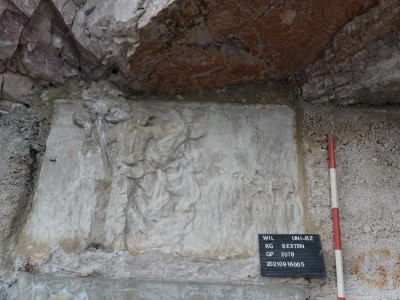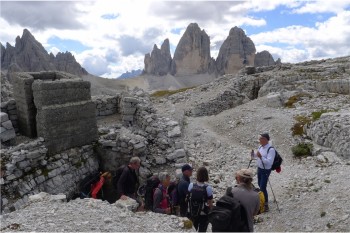The research project "Written in the landscape. Places, traces and memories of the First World War in the Sesto Dolomites", financed by the “Research Südtirol/Alto Adige 2019” fund, investigated with a multidisciplinary approach the traces that the tragic events of the First World War have left in the landscape of the Three Peaks area and in the memories of the people. The complex and layered set of places, material traces and intergenerational oral memories of the First World War constitutes a “painful” and “dissonant” heritage for the inhabitants of a territory that is today predominantly perceived as a UNESCO natural heritage and attractive tourist region. The project aimed to unveil the complexity of the landscape of the Dolomites, going beyond the dichotomy of natural / cultural heritage to search and redeem the living memories of war embedded in sites and places, promoting awareness of the conflictual and often ideologized heritage inscribed in this territory, beyond regional and national borders.
Written in the landscape. Places, traces, and memories of the World War I in the Sesto Dolomites

Objectives and Methodology
During the First World War, both the Austro-Hungarian and Italian armies built a complex infrastructure system on the Three Peaks Plateau, traces of which are still visible in this iconic mountain landscape. Tracing, documenting and studying these signs offers the possibility of restoring the complex landscape stratification of this territory and its history, both deeply intertwined with the cultures of memory of the local populations and in particular with the local community of Sesto. The home front, which was badly affected by the events of the war in the high mountains, was often marginalized in official accounts and barely researched scientifically. The village of Sesto/Sexten, which was almost completely destroyed in 1915, saw its inhabitants forcibly evacuated, and was only rebuilt after the war, was also the subject of research.
The project linked the documentation and study of the numerous material traces of the war – such as trenches, emplacements, caverns, paths, cableways, accommodation barracks, camps, inscriptions, supply structures, etc. – inscribed in the landscape but often difficult to identify and interpret, with the study of collective and individual memories of the war years, as part of the history of local families and communities. To do this, the project adopted different methodological approaches, such as conflict archaeology, historical-archival documentation, socio-cultural research and the participation of local communities in the dissemination and co-production of a common heritage.








Dissemination of the research results
The impact of the project and its innovative approach had strongly positive effects at local, national and international level, in academic circles as well as in civil society. The dissemination of research results has provided for heterogeneous formats for this purpose, including an exhibition (Former Monte Elmo Cable Car, Sesto/Sexten, 7.08–25.09.22), an international conference (Sesto/Sexten, 2-4.09.22), a scientific publication (now in preparation) and a dedicated web page, which organized and collected a meaningful synthesis of research results in a format open to the public. There were also participatory events, guided tours and itineraries and an app designed to accompany visits to the places of the project. In doing so, the project allowed local people and visitors to take a new critical look at the dissonant and conflictual heritage of the war landscape, promoting shared knowledge and social participation.
Download here:

The exhibition
The exhibition “Scritto nel Paesaggio / In die Landschaft eingeschrieben”, curated by Waltraud Kofler Engl and Elisabetta Rattalino, was mounted by the team of the Platform Cultural Heritage Cultural Production of the Faculty of Design and Art of the Free University of Bozen-Bolzano to present the preliminary results of research conducted for the interdisciplinary project “Written in the landscape. Places, traces and memories of the First World War in the Sesto Dolomites.”
The exhibition presented diverse materials: a selection of historical archival documents and photographs; a video documentation of the surveys on the Three Peaks Plateau and a selection of the photographs taken during the documentation carried out by the conflict archaeologists in the summer of 2021; and “Voci della memorie – La Prima Guerra Mondiale a Sesto/Stimmen der Erinnerung- Der Erst Weltkrieg in Sexten”, a film that brings together individual and collective memories of the destruction in Sesto/Sexten in 1915, of the evacuation and the return of the civilian population, and of the difficult reconstruction in the years from 1918 to 1923.
The heterogeneity of the materials displayed in the exhibition not only made visible the interdisciplinary synthesis of historical source research – conducted in various archives in South Tyrol, but also in Rome, Vienna and Innsbruck – with the documentation of the military infrastructures in the wartime landscape and the examination of the cultures of remembrance in Sesto/Sexten and the surrounding area, but also contributed to the multimedia exhibition narrative dedicated to the Three Peaks Plateau and the complex historical stratifications of this landscape, which today is predominantly perceived as a tourist destination and UNESCO natural heritage site.
The valley station of the St. Elmo cable car in Sesto/ Sexten in Val Pusteria/Pustertal, now abandoned, played host to the exhibition in the summer of 2022. The exhibition’s itinerary, developed over two floors, was organized into three thematic sections. On the upper floor, there was “Infrastructure” and “Two Fronts”, while “Heimatfront: Destruction, Emigration and Construction in Sesto/Sexten” was on the lower floor.
Artistic interventions by current and former students of the Faculty of Design and Art of the Free University of Bozen-Bolzano were integrated into the scientific-documentary exhibition path. Some of these works questioned the way in which history – even at its most dramatic – is embedded in territories and landscapes without leaving visible traces; other works evoked the forms of violence– different but always salient – that war brings. Further works put us in touch with our painful conditions of fragility in coping with war.






Partners
The Platform Cultural Heritage Cultural Production of the Faculty of Design and Art (unibz) led the research activities in collaboration with the Faculty of Education.
The society for archaeological research Arc-team, and four associations of experts in the fields of regional and military history (Austrian Society for Fortification Research, Museum of the War of Rovereto, Bellum Aquilarum Onlus), and cultural anthropology (EVAA-Anthropological Association South Tyrol), together with the Tourism Association of Sesto and the Sesto municipality supported the research and dissemination activities of the project. The expertise of the research group’s members in diverse fields, such as archaeology and history of the conflicts, cultural anthropology and geography, sociology, heritage studies and conservation, art and design, has been crucial to the project’s interdisciplinary approach.
Team
PI Dr. Waltraud Kofler Engl, Director of the Platform Cultural Heritage Cultural Production, Faculty of Design and Art, Free University of Bolzano
Co-I Alexandra Budabin, AR, Faculty of Design and Art, Free University of Bozen
Co-I Dr. Gaia Piccarolo, AR, Faculty of Design and Art, Free University of Bolzano
Project collaborators
Prof. Susanne U. Elsen, Faculty of Education, Free University of Bolzano
Prof. Andrea Di Michele, Senior Researcher, Faculty of Education, Free University of Bolzano
Prof. Alessandro Luigini, Faculty of Education, Free University of Bolzano
Prof. Stephan Schmidt-Wulffen, Faculty of Design and Art, Free University of Bolzano
Dr. Daniela Salvucci, Junior Researcher, Faculty for Education, Free University of Bolzano
EVAA - Associazione Antropologica Sud Tirolo, Dr. Stefan Festini Cucco, President
Museo della Guerra, Rovereto, Dr. Francesco Frizzera, Director & Dr. Nicola Fontana, Responsabile dell’Archivio Storico
Rupert Gietl, Founding Partner, Arc-Team
Associazione Turistica di Sesto, Maria Luise Hofer
Bellum Aquilarum Onlus, Dr. Sigrid Wisthaler, Director & Pietro Michieli, Honorary Member and Vice-President
Austrian Society for Fortification Research, Dr. Reinfrid Vergeiner, Vice-President
Researchers
Dr. Thomas Benedikter, Researcher, Platform Cultural Heritage Cultural Production, Faculty of Design and Art, Free University of Bolzano
Gianluca Fondriest, Researcher, Platform Cultural Heritage Cultural Production, Faculty of Design and Art, Free University of Bolzano
Sabine Viktoria Kofler, Researcher, Platform Cultural Heritage Cultural Production, Faculty of Design and Art, Free University of Bolzano
Claudia Polizzi, Researcher, Platform Cultural Heritage Cultural Production, Faculty of Design and Art, Free University of Bolzano
Dr. Elisabetta Rattalino, Researcher, Platform Cultural Heritage Cultural Production, Faculty of Design and Art, Free University of Bolzano